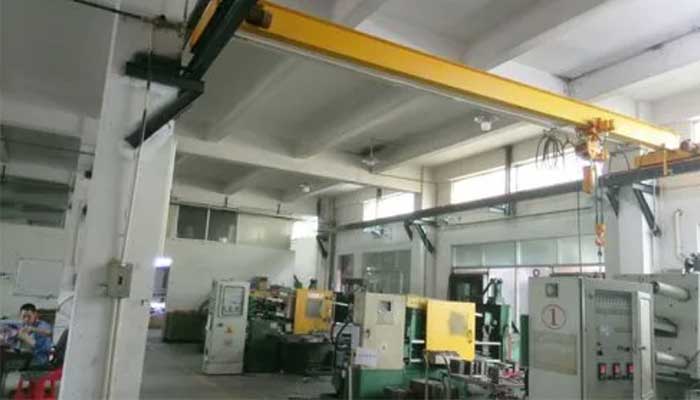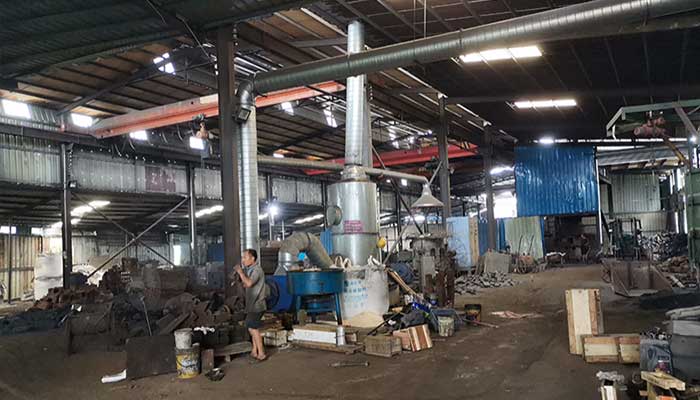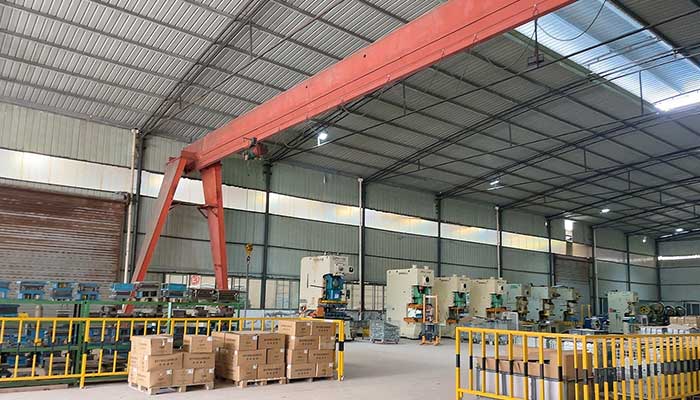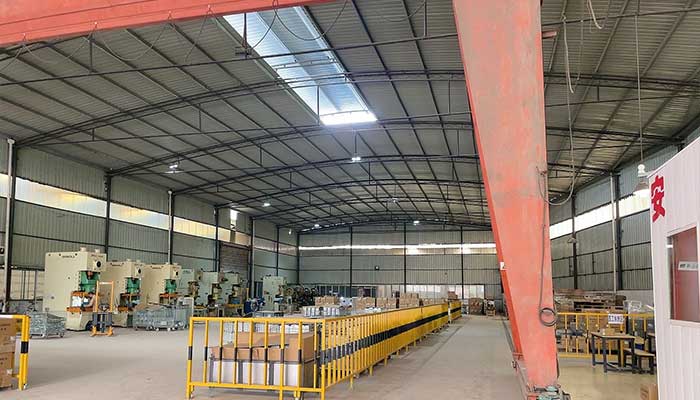Overhead Crane for Hardware Manufacturing 5 Ton, 10 Ton, 20 Ton
Overhead crane for hardware manufacturing. Custom overhead crane 5 ton, 10 ton, 20 ton, 30 ton for hardware manufacturing from metals to medical devices
From Metals to Medical Devices: Overhead Cranes in Specialized Hardware Manufacturing
In the vast realm of manufacturing, the production of specialized hardware, ranging from aerospace components to automotive parts and delicate medical devices, is a crucial sector that requires precision, safety, and efficiency. Within these highly specialized subsectors, one indispensable tool stands out as the backbone of production – overhead cranes. Overhead cranes, also known as bridge cranes or gantry cranes, have a unique ability to adapt to the distinct requirements of different hardware manufacturing industries, playing a pivotal role in ensuring that each product meets the highest quality standards.
Specialized hardware manufacturing refers to the production of unique and specific components, parts, or products tailored to meet the distinct requirements of various industries. It encompasses the design, fabrication, and assembly of hardware that often demands a high degree of precision, adherence to stringent safety standards, and operational efficiency. This sector is characterized by its focus on creating specialized, often custom-made, components that are integral to diverse industries such as aerospace, automotive, and medical devices. Specialized hardware manufacturing plays a vital role in supporting these industries by providing them with the necessary components and parts that are integral to their operations.
top running overhead crane for hardware manufacturing 2 ton, 3 ton, 5 ton, 10 ton
Key Subsectors within Specialized Hardware Manufacturing
Aerospace Hardware Manufacturing:
Aerospace hardware manufacturing is a subsector dedicated to producing components used in the aviation and space exploration industries. It involves the manufacture of aircraft parts, engines, and space exploration equipment. The components used in aerospace must adhere to the strictest quality and safety standards due to the critical nature of the industry, and precision is paramount. As a result, this subsector requires specialized processes and equipment to ensure the integrity and safety of the produced components.
Automotive Hardware Manufacturing:
Automotive hardware manufacturing focuses on creating parts and components for vehicles, including cars, trucks, and other modes of transportation. This subsector operates at a high volume and fast pace, aiming for cost-effectiveness and efficiency while maintaining quality. Precision and safety are crucial, particularly for components like brakes, engines, and airbags, which are essential for vehicle safety and performance. The subsector demands adaptability to cater to a wide variety of parts and materials used in automotive manufacturing.
Medical Device Hardware Manufacturing:
Medical device hardware manufacturing involves the production of precision medical equipment, such as surgical instruments, diagnostic devices, and implants. The medical industry places a strong emphasis on cleanliness, precision, and safety. The components used in medical devices must adhere to rigorous quality and regulatory standards, making this subsector unique in its requirements. Cleanroom manufacturing and strict quality control are essential for ensuring the safety and effectiveness of medical devices.
Significance of Precision, Safety, and Efficiency in These Subsectors
Precision, safety, and efficiency are central to the success and viability of specialized hardware manufacturing in each of these subsectors:
- Precision: Precision is crucial in specialized hardware manufacturing as even the smallest deviation from design specifications can result in critical errors or failures in the end product. In aerospace manufacturing, for example, a minor imperfection can lead to catastrophic consequences during flight. Likewise, precise machining and assembly are essential in the automotive industry to ensure the safe and reliable operation of vehicles. In medical device manufacturing, precision is a matter of life and death, as the accuracy of devices directly impacts patient well-being.
- Safety: Safety is a paramount concern in all specialized hardware manufacturing subsectors. Aerospace hardware must meet rigorous safety standards to ensure the safety of passengers and crew. In the automotive industry, safety components such as airbags and braking systems are essential for protecting occupants. In medical device manufacturing, the safety and effectiveness of equipment directly impact patient health, and strict adherence to safety protocols is non-negotiable.
- Efficiency: Efficiency is key to maintaining competitiveness and meeting production demands in specialized hardware manufacturing. Automotive manufacturing, with its high volume and rapid pace, must optimize production processes to remain cost-effective. Aerospace manufacturing must balance precision with efficiency to meet project timelines. In medical device manufacturing, the efficient production of lifesaving equipment is crucial to meet the ever-increasing demand for healthcare solutions.
In summary, the specialized hardware manufacturing sector operates within the niche requirements of aerospace, automotive, and medical device manufacturing, each with its unique set of demands, emphasizing precision, safety, and efficiency as the cornerstones of its success. The adaptation and utilization of overhead cranes play a pivotal role in addressing these demands, as we will explore further in this article.
Single girder overhead crane and bridge crane for hardware part manufacturing
The Role of Overhead Cranes in Hardware Manufacturing
Overhead cranes, also known as bridge cranes or gantry cranes, are sophisticated material handling systems that play a critical role in specialized hardware manufacturing. They consist of a horizontal bridge that moves along elevated runways, with a hoist mechanism capable of lifting, lowering, and moving heavy loads both horizontally and vertically. These cranes are engineered to provide precision, control, and flexibility in handling materials, making them essential tools in the manufacturing process.
The primary functions of overhead cranes include:
- Lifting and Lowering: Overhead cranes have the capacity to lift heavy objects, such as raw materials, components, and finished products, with exceptional precision and control. This is particularly important in specialized hardware manufacturing, where precision is paramount.
- Horizontal Movement: Overhead cranes can transport materials across the factory floor, positioning them precisely where needed. Their ability to move laterally, often with variable speed and precision, is essential for efficient manufacturing processes.
- Vertical Movement: Overhead cranes are capable of lifting materials to different elevations within the manufacturing facility. This is especially valuable when assembling or moving large components or products in multi-story facilities.
- Placement and Positioning: Overhead cranes enable precise placement and positioning of materials, ensuring that components are in the right place at the right time. This precision is crucial in maintaining product quality and assembly efficiency.
Importance of Material Handling in Hardware Manufacturing
Material handling is a fundamental aspect of hardware manufacturing, as it influences every stage of the production process. The significance of material handling can be highlighted through the following points:
- Workflow Efficiency: Efficient material handling ensures that raw materials, work-in-progress, and finished products are moved smoothly and in a well-organized manner throughout the manufacturing facility. This optimized workflow is essential to meet production goals.
- Quality Control: Material handling impacts product quality by reducing the risk of damage or contamination during transport. Overhead cranes provide precise control, minimizing the potential for errors and ensuring that components are handled carefully.
- Safety: In hardware manufacturing, safety is of utmost concern. Material handling accidents can lead to injuries and delays. Overhead cranes help reduce the risk of accidents associated with manual lifting and handling of heavy materials, promoting a safer work environment.
- Space Utilization: Overhead cranes make efficient use of vertical space, maximizing the available floor are This is particularly important in industries with limited space, such as automotive manufacturing.
General Benefits of Using Overhead Cranes in Manufacturing
The use of overhead cranes in manufacturing offers a wide range of benefits that extend beyond specialized hardware manufacturing. Some of these advantages include:
- Labor Savings: Overhead cranes reduce the need for manual labor in material handling, leading to cost savings and minimizing the risk of injury for workers.
- Increased Productivity: Overhead cranes can move materials quickly and efficiently, reducing downtime and increasing overall productivity in manufacturing processes.
- Precision and Control: Overhead cranes provide precise control, ensuring that materials are positioned with accuracy and minimizing errors in assembly.
- Adaptability: Overhead cranes can be customized and adapted to various manufacturing needs, making them versatile tools in different industries.
- Safety: Overhead cranes are equipped with safety features, reducing the risk of accidents associated with material handling.
In summary, overhead cranes serve as indispensable tools in specialized hardware manufacturing by providing the means for efficient material handling. Their versatility, precision, and safety features make them invaluable in meeting the unique requirements of aerospace, automotive, and medical device manufacturing. The adaptability of overhead cranes to these industries underscores their significance as the backbone of production in these subsectors.
Single girder ganry crane for indoor use in hardware processing factory
Adaptability to Different Subsectors
Overhead Cranes in Aerospace Hardware Manufacturing
Unique Requirements in Aerospace Manufacturing
Aerospace hardware manufacturing is characterized by stringent quality and safety standards. The unique requirements in this industry include:
- Precision: Components must meet strict tolerances and quality standards to ensure the safety and reliability of aircraft and space equipment.
- Material Integrity: Aerospace components are often made from advanced materials that require careful handling to prevent damage.
- Cleanroom Compatibility: Aerospace facilities often operate in cleanroom environments to minimize contamination risks.
How Overhead Cranes Address Those Requirements
Overhead cranes in aerospace manufacturing are adapted to address these requirements through:
- Precision Controls: Overhead cranes are equipped with advanced control systems, allowing for precise movements and positioning.
- Material Handling Attachments: Specialized lifting attachments ensure that delicate aerospace components are handled with care.
- Cleanroom Features: Overhead cranes in aerospace facilities may have cleanroom compatibility, ensuring that components are not contaminated during transport.
Overhead Cranes in Automotive Hardware Manufacturing
Distinctive Needs of the Automotive Industry
The automotive industry is characterized by high production volumes, fast-paced assembly, and a wide variety of components. Distinctive needs in this sector include:
- High Volume: Automotive manufacturing facilities require efficient material handling to keep up with high production volumes.
- Component Diversity: Overhead cranes must be adaptable to handle various types of materials, from metal sheets to sensitive electronic components.
- Efficiency: Rapid and efficient material movement is critical to meeting production timelines and cost-effectiveness.
Adaptations and Features of Overhead Cranes for Automotive Manufacturing
Overhead cranes designed for automotive manufacturing offer the following adaptations and features:
- Automation and Robotics Integration: Overhead cranes can be integrated with automation and robotics to handle materials quickly and efficiently.
- Variable Speed and Precision: Overhead cranes can operate at variable speeds and offer precise control to accommodate diverse manufacturing needs.
- Load Handling Capacity: Cranes designed for automotive facilities can handle heavy loads, such as large car body components, with ease.
Overhead Cranes in Medical Device Hardware Manufacturing
Specialized Demands of Medical Device Manufacturing
Medical device hardware manufacturing has distinct demands due to the need for precision, cleanliness, and adherence to regulatory standards. Unique requirements include:
- Cleanroom Standards: Medical device manufacturing often occurs in cleanrooms with controlled environments to maintain sterility.
- Quality Control: Rigorous quality control processes are essential to meet regulatory and safety standards.
- Delicate Handling: Medical device components are often fragile and require careful, damage-free handling.
How Overhead Cranes Cater to These Demands
Overhead cranes in medical device manufacturing are tailored to cater to these specialized demands by offering:
- Cleanroom Compatibility: Overhead cranes in these facilities are designed to meet cleanroom standards to prevent contamination.
- Quality Control Features: These cranes may come equipped with documentation and quality control systems to ensure regulatory compliance.
- Specialized Lifting Attachments: Overhead cranes are equipped with attachments designed for gentle and precise handling of delicate medical device components.
In summary, overhead cranes demonstrate their adaptability by addressing the unique requirements of aerospace, automotive, and medical device manufacturing subsectors. Their ability to provide precision, safety, and efficiency in material handling makes them an integral component of production processes in each of these industries, ensuring that the specific demands of each subsector are met with precision and reliability.
rail mounted gantry crane for hardware processing factory
Safety and Compliance
Regulatory Requirements in Specialized Hardware Manufacturing
Specialized hardware manufacturing, whether in aerospace, automotive, or medical device sectors, is subject to strict regulatory standards to ensure product safety and quality. The specific regulatory requirements in these industries may include:
Aerospace Manufacturing:
- Federal Aviation Administration (FAA) regulations: These standards dictate the quality and safety requirements for aerospace components to ensure the reliability of aircraft.
- International Air Transport Association (IATA) regulations: These global standards cover the transportation of aerospace components and focus on safety and security.
Automotive Manufacturing:
- International automotive standards (e.g., ISO/TS 16949): These standards define quality management systems for automotive production and assembly, emphasizing product safety and reliability.
- Vehicle safety standards (e.g., Federal Motor Vehicle Safety Standards - FMVSS): These regulations mandate safety features such as airbags, seat belts, and braking systems.
Medical Device Manufacturing:
- U.S. Food and Drug Administration (FDA) regulations: FDA regulations are extensive, covering all aspects of medical device manufacturing, from design and production to quality control and labeling.
- ISO 13485: This international standard for medical device quality management systems ensures adherence to global quality and safety requirements.
The Role of Overhead Cranes in Ensuring Safety and Compliance
Overhead cranes play a pivotal role in specialized hardware manufacturing by contributing to safety and compliance in several ways:
- Precision Handling: Overhead cranes provide precise and controlled material handling, minimizing the risk of damage to critical components. This precision ensures that products meet the exact specifications required by regulatory bodies.
- Cleanroom Compatibility: In industries like aerospace and medical device manufacturing, where cleanroom environments are essential to prevent contamination, overhead cranes can be designed to meet cleanroom standards. This helps maintain the cleanliness and integrity of components during transportation.
- Quality Control: Overhead cranes can be equipped with documentation and quality control features, enabling manufacturers to maintain meticulous records of component handling and ensure compliance with regulatory requirements.
- Safety Features: Overhead cranes are equipped with advanced safety features, such as overload protection, emergency stop buttons, and safety interlocks, to prevent accidents and injuries during material handling.
- Documentation and Traceability: Overhead cranes can incorporate data logging and tracking systems, enabling manufacturers to trace the history of components and verify adherence to regulatory requirements.
Examples of How Adherence to Safety Standards Is Achieved
Let's look at a few case studies or examples to illustrate how overhead cranes contribute to adherence to safety and compliance standards in specialized hardware manufacturing:
- Aerospace Case Study: A leading aerospace manufacturer utilizes overhead cranes with precision controls and cleanroom compatibility. These cranes help maintain the cleanliness and quality of components during transport, ensuring compliance with FAA and IATA standards. By utilizing overhead cranes, the manufacturer significantly reduces the risk of component damage or contamination during the production process.
- Automotive Example: An automotive assembly plant incorporates overhead cranes with advanced automation and safety features. These cranes handle heavy automotive components efficiently, meeting FMVSS standards for product safety. The automated systems reduce the risk of accidents during transportation, improving both safety and compliance.
- Medical Device Case Study: A medical device manufacturer installs overhead cranes with quality control features, including documentation and traceability functions. These cranes assist in ensuring compliance with FDA and ISO 13485 regulations. By maintaining meticulous records and traceability, the manufacturer can quickly demonstrate compliance during audits and inspections.
In summary, overhead cranes are integral to specialized hardware manufacturing, as they contribute to adherence to safety and compliance standards set by regulatory bodies. Their precision, cleanroom compatibility, quality control features, and safety mechanisms help manufacturers meet the stringent requirements of the aerospace, automotive, and medical device industries, ensuring the safety and quality of their products.
Conclusion
Overhead cranes have demonstrated remarkable adaptability across various hardware manufacturing subsectors, including aerospace, automotive, and medical device industries. These industries present unique and stringent requirements, such as precision, safety, and compliance, making overhead cranes an indispensable tool. The adaptability of overhead cranes is evident in their capacity to address the distinct needs of each sector, ensuring the efficient handling of materials, precision in manufacturing processes, and adherence to regulatory standards.
The crucial role played by overhead cranes in specialized hardware manufacturing cannot be overstated. They serve as the backbone of production in aerospace, automotive, and medical device manufacturing by providing a safe, efficient, and precise means of material handling. Overhead cranes contribute to achieving the highest standards of quality, ensuring that components and products meet the exact specifications required by each industry. They help manufacturers maintain cost-effectiveness, improve productivity, and ensure the safety of their workforce.
In the specialized hardware manufacturing subsectors of aerospace, automotive, and medical devices, precision, safety, and efficiency stand as the three pillars of success. Overhead cranes directly address these crucial aspects:
- Precision: Overhead cranes offer precise control and movements, ensuring that components are handled with accuracy and care. This precision is vital for meeting the strict tolerances and quality standards in these industries.
- Safety: Overhead cranes are equipped with advanced safety features to minimize the risk of accidents during material handling. This is particularly important in industries where safety is paramount.
- Efficiency: Overhead cranes streamline material handling processes, reducing downtime, optimizing workflow, and supporting rapid production. Efficiency is a critical factor in meeting production goals and remaining competitive.
In conclusion, overhead cranes are not only a symbol of adaptability but also the cornerstone of success in specialized hardware manufacturing. Their ability to address the unique requirements of aerospace, automotive, and medical device manufacturing subsectors emphasizes their significance as essential tools for achieving precision, safety, and efficiency in these industries. As technology and innovation continue to drive progress in manufacturing, overhead cranes will undoubtedly play an increasingly pivotal role in meeting the evolving needs of these critical sectors.




